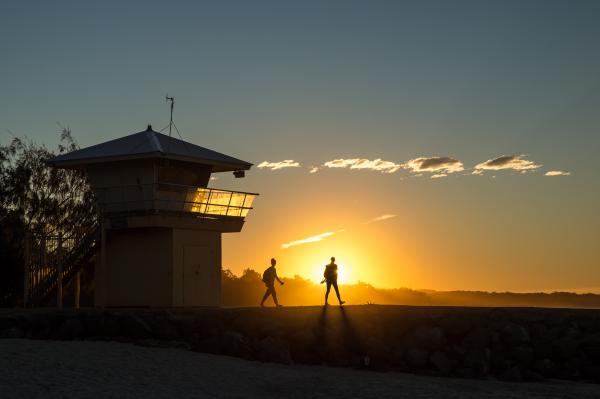Once again, they are in the news. The shark nets of Noosa. These nets were laid following a number of shark attacks along the Queensland coast, one of which occurred, unfortunately, at Noosa’s Main Beach, about 6.30am on 18 December 1961. As a result of this and other incidents, many projects were undertaken by both government and private groups to find a solution that would hopefully establish a method of safety to protect our beaches. Finally, the idea of the nets was accepted. The next step was where they should be placed. These areas were selected after an expert on the shark problem conducted a survey from a light aircraft, and the project was soon under way.
For the coastal area of Noosa, nets were laid at Sunshine Beach and Noosa Main Beach. This was, of course, a welcome sight for our locals as the recent tragedy had a massive effect on the struggling tourist industry. But most of all, it came as a blessing to the volunteer lifesavers who, for several years, had been patrolling Noosa’s Main Beach with the shark problem being of major concern. The cause of our concern was the fact that least every second or third weekend a patrol would sound the shark alarm and the surf would have to be cleared.
This often resulted in lifesavers, some not knowing the whereabouts of the unwanted visitor, having to swim out and either drag or assist swimmers back to shore. So common were these incidents, that on occasions when a shark was spotted cruising around the then-small reef at First Point, a patrolman would paddle out on a surf ski, and sitting some 50-80 metres west of the Point, watch the activities. If it turned and started swimming toward the beach, the patrolman would raise the alarm and the beach would be cleared. If it turned out to sea, then he would follow for some distance, then give the all- clear signal. Two types that were most common were the tiger and the bronze whaler with the tiger being considered most dangerous.
Before the trendies discovered our “quiet, very quaint, sleepy little fishing village, called Noosa,” our beach would have very few visitors, so, when Noosa’s First Point was at its best with a nice green 2-3-metre body wave (a common occurrence in those days), the members would body surf to their heart’s content. This was also before the invention of the surf board. The only problem that would interrupt a beautiful morning was when, and this was a common occurrence, some clown would call out, “Look behind yuh.” On doing so we would turn to see our few visitors, jumping up and down on the beach and pointing. Sure enough, there would be fin breaking the surface as a “munchie” cruised slowly up and down the gutter between us and the beach. After scaring the hell out of mum, dad, kids and clubbies, it would turn and go out to sea.
Our saving factor was, according to the Massoud family, (our local legendary fishermen), that the North Reef, a mile out from Main Beach and Jew Shoal, out from National Park, was loaded with fish. Jew Shoal in particular, was once referred to by a team of professional divers as being home to the big menace, the tiger shark. At this stage, there was not a clubbie who did not have his favourite shark story with some encounters being up close, like when a shark swam between the legs of clubbie Merv “Sputtie” Cummings while body surfing.
Then there was the happy proud mother, watching as her five-year-old son, standing in waist deep water having fun jumping up and down in a gutter. It was 6am on a Saturday and the flags were about to be raised. Suddenly the cry of “shark!” made the patrol look toward the gutter. There, some 60 metres away, a two- metre bronze whaler was slowly moving towards the child. Dropping the flagpole, patrolman Norm Adams, known as Nudie, without a moment’s hesitation ran into the water, picked up the child and backed up onto the beach. The shark swam past, turned and moved out to sea. The hysterical mother grabbed her son and then gave Nudie the biggest hug he had ever had. Nudie’s patrol mates gave him a big thumbs up and yelled “Good on yuh mate!” That was it. No big deal, just another shark incident in the “No Net Days at Noosa’s Main Beach”.
The shark netting came about as a result of a shark control conference, initiated by the Nicklin Government in January 1962, resulting in the first permanent netting in November of that year. As a result of this, 32 sharks were netted in the first week that the nets were introduced in the Noosa region. However, one problem became apparent. The big boys, five and six metres, were too big and strong to hold. This was resolved when a stronger type of mesh was used in the making of the nets. But for us on patrol, we started to notice a change. Since the introduction of the nets, the shark incidents and alarms started to diminish. Happy to relate, this in fact became a reality. In discussions with several veteran patrolman, they agreed that in their 10-year period they had experienced very few incidents. Also, the number of sharks netted was reducing.
Why is hard to answer. It doesn’t mean that more sharks are being killed. However, more than one experienced underwater explorer has come to believe nature has created a type of warning system within the body that causes sharks to avoid certain areas or objects. Unbelievable as it seems, it does make us wonder. The manufacture of a successful shark repellent has been tested by some of the world’s best, the US Navy and, most important of all, what many experienced divers class as one of the best underwater exploration teams, the Calypso-Cousteau people – neither of which have come up with a 100 per cent repellent. But again, it brings us back to our experiences at Noosa’s Main Beach. This tells us that, believe it or not, since the Noosa nets were introduced in November 1962, our shark incidents have been reduced by a massive 80-90 per cent. So why is it that when we have had hundreds of lifesavers, who over the years have patrolled our beach and can confirm these statements, that the five-minute experts, who are unknown to our experienced patrolmen, come into our “quaint little sleepy fishing village” and tell us that, much to their frustration, ‘’it (the shark netting) is not even effective”. As a result of their research, they have also discovered that the nets are located “about 80-90m from the shore” when, in fact, they are set some 200-300m out to sea.
Regarding our tourists being upset having to watch humpback whales drowning while on a shopping expedition in Hastings Streets shows the lack of respect for the mentality of our visitors. It is absolutely impossible to view Main Beach from Hasting Street. This, however, could be overcome if our tourist industry was to publish a travellers’ brochure advertising the where and how to hire extension ladders. Hysterical statements and rash actions will not help provide solutions for other resorts that have not been fortunate enough to have achieved a successful shark net system such as we have at Noosa. Only the foolish would want to destroy what has worked for us at Noosa Main Beach when they do not, repeat, do not have another system ready to go already tested and perfect. This is something that man will never find as the ocean has and always will be home to what the legendary Jacques-Yves Cousteau once described as the perfect killing machine, the shark. Experience, the greatest teacher of all, tells us that Noosa nets, must, for now, stay as is.







